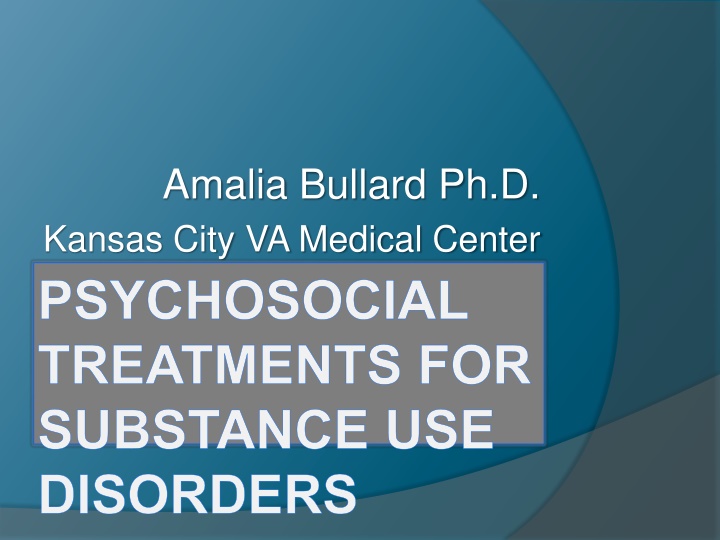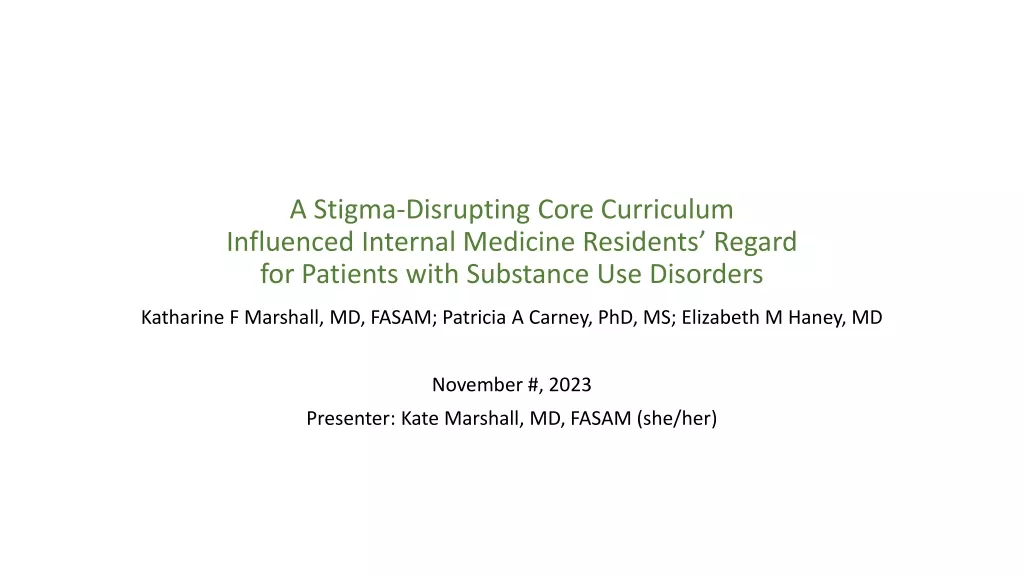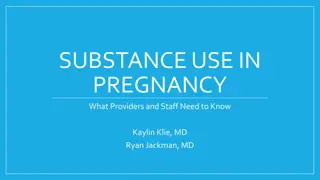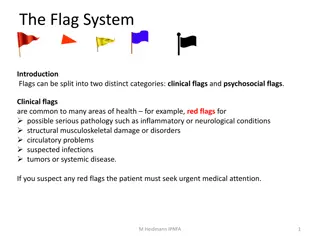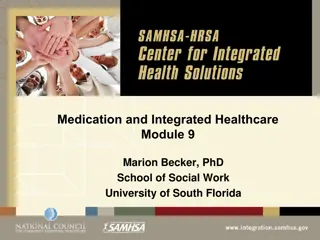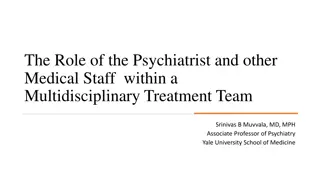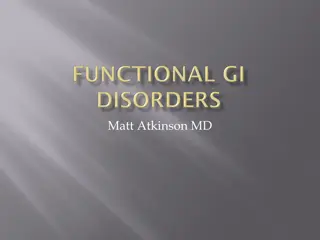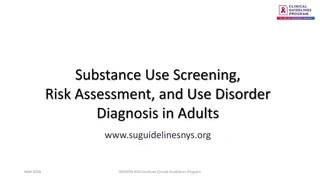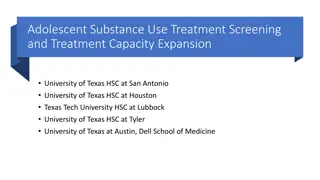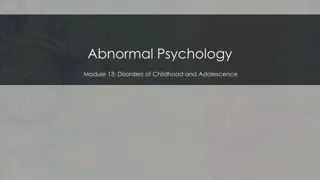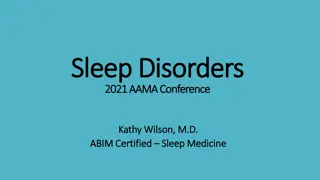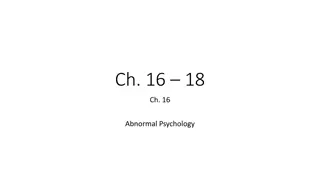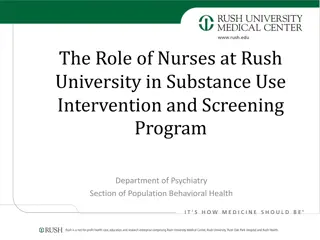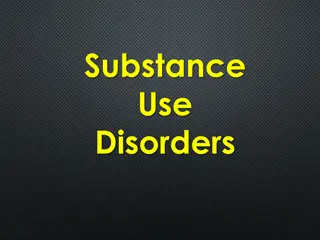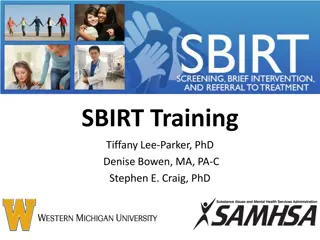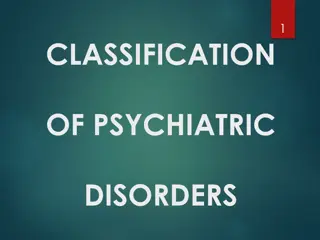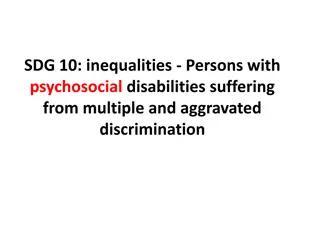Psychosocial Treatments for Substance Use Disorders: Strategies and Interventions
Delve into the world of psychosocial treatments for substance use disorders with Dr. Amalia Bullard at Kansas City VA Medical Center. Explore empirical-supported interventions, motivational interviewing, cognitive behavioral therapies, and more to understand the mechanisms of change and the importance of a therapeutic alliance in achieving sobriety and continued care.
Download Presentation

Please find below an Image/Link to download the presentation.
The content on the website is provided AS IS for your information and personal use only. It may not be sold, licensed, or shared on other websites without obtaining consent from the author.If you encounter any issues during the download, it is possible that the publisher has removed the file from their server.
You are allowed to download the files provided on this website for personal or commercial use, subject to the condition that they are used lawfully. All files are the property of their respective owners.
The content on the website is provided AS IS for your information and personal use only. It may not be sold, licensed, or shared on other websites without obtaining consent from the author.
E N D
Presentation Transcript
Amalia Bullard Ph.D. Kansas City VA Medical Center PSYCHOSOCIAL TREATMENTS FOR SUBSTANCE USE DISORDERS
Sobriety is more than not using It is creating a new life that supports it.
Objectives Psychosocial interventions with empirical support Treatments with promise Integrated treatment of co-occurring disorders Mechanisms of change Role of therapeutic alliance and therapist characteristics Importance of continuation of care
Psychosocial Interventions with Psychosocial Interventions with Empirical Support Empirical Support Motivational Interviewing Cognitive Behavioral Interventions Contingency Management 12-Step Facilitation Community Reinforcement Approach Behavioral Couples and Family Therapies
Motivational Interviewing (MI) Motivational Interviewing (MI) A goal-oriented, client-centered counseling style for eliciting behavior change by helping patients to explore and resolve ambivalence.
Motivational Interviewing Motivational Interviewing Having more effective conversations about changing substance use
Patients dont do what they should should because: Solution = Tell them what to do Don t know what they need to be doing Solution = Tell them why doing what I say is so important Lazy or weak willed Solution = scare, convince, persuade, them to do what I say Denial or don t believe what I have to say
The Righting Reflex The Righting Reflex The desire to fix what seems wrong with people and to set them promptly on a better course. What could possibly be wrong with that?
Ambivalence Ambivalence - - getting stuck on getting stuck on the road to change the road to change Simultaneously wanting and not wanting something, or wanting both of two incompatible things Change talk and sustain talk Getting stuck in ambivalence Think about changing think about not changing stop thinking about it
Ambivalence the Internal Ambivalence the Internal Committee Committee What happens when an ambivalent person meets a provider with a righting reflex? Argue for one side and the person is likely to take up the other side and defend the opposite. Most people tend to believe themselves and trust their own opinions more than those of others. If you are arguing for change and your patient is arguing against it, you ve got it exactly backwards.
Tug of War Tug of War Pt: I know I should quit drinking, but it s the only way I can sleep through the night without the nightmares. Dr.: You re right. You really need to cut back on the alcohol. If you don t then Pt: I know all of that, but if I don t drink to sleep, I wake up with my heart racing out of my chest and I feel like I m back over in Iraq. And then there s no way I can get back to sleep.
An Alternative MI Pt: I know I should quit drinking, but it s the only way I can sleep through the night without the nightmares. Dr.: If it weren t for the nightmares, you would be okay with cutting back. Pt: Yeah, I d be fine with it. I know that much alcohol isn t good for me and it will probably just make things worse in the long run.
The Spirit of Motivational The Spirit of Motivational Interviewing Interviewing If you treat an individual as he is, he will stay as he is, but if you treat him as if he were what he ought to be and could be, he will become what he ought to be and could be. Johann Wolfgang Von Goethe
The Spirit Mind The Spirit Mind- -set/Heart set/Heart- -set set Partnership Acceptance Compassion Evocation
Key Principles of MI Key Principles of MI Express (sincere) empathy Develop discrepancy Roll with resistance Support Self-efficacy
Evoking Motivation for Change Ambivalence resolves by tipping the balance in favor of change. People tend to become more committed to what they hear themselves saying. The importance of speaking one s motivation aloud in the presence of another person.
Change Talk and Sustain Talk vary with Counselor Approach Glynn and Moyers 2010 80 70 60 50 Change Talk Sustain Talk 40 30 20 10 0 FA-1 CT-1 FA-2 CT-2
Cognitive Behavioral Cognitive Behavioral Targets intrapersonal & interpersonal triggers social pressures, cravings, conflict in relationships Coping skills training drug refusal skills Builds sober healthy activities
Relapse Prevention Relapse Prevention A Cognitive behavioral approach addressing the relapse process in order to prevent relapses and minimize harm of relapses that do occur Relapse return to use/drinking following period of abstinence or period of lower level of use/drinking
Relapse Prevention Relapse Prevention Relapse is not viewed as an end- state, but rather as a process that begins before use of the substance and continues afterward.
Relapse Prevention Relapse Prevention Patients relapse because they lack cognitive & behavioral skills to cope with immediate determinants/ covert antecedents Immediate determinants environmental/emotional characteristics of situations associated with relapse Covert antecedents subtler, often broader factors that predispose patients to relapse
Relapse Prevention Relapse Prevention Examine previous use/drinking episodes in order to identify what the immediate determinants and covert antecedents have been in the past What new information and strategies are needed in to order address weaknesses in patients cognitive and behavioral skill set?
Immediate Determinants Immediate Determinants High Risk Situation High Risk Situation Lack of coping skill & confidence Coping skill and self- efficacy Abstinence violation effect & relapse Decreased risk of relapse
Covert Antecedents Covert Antecedents Increase risk of relapse by increasing chance of exposure to high risk situations Seemingly irrelevant decisions call cousin to see how he s doing, keep alcohol in the house for guests Lifestyle factors imbalance of wants vs shoulds lack of pleasurable or meaningful activities Urges/cravings desire for immediate gratification
Relapse Prevention Strategies Relapse Prevention Strategies Examine previous episodes for high risk situations and teach new coping skills Positive Expectancies Enhance self-efficacy Retrain thinking about lapse and relapse to help combat abstinence violation effect Teach lapse management by creating lapse-response plan
Contingency Management Contingency Management A behavioral approach to reinforce abstinence from substance use The goal s to provide patients with a period of abstinence
Contingency Management Contingency Management Based on principles of operant conditioning Positive reinforcers increase probability of behavior Raises/awards, allowances/privileges, treats/food Punishers decrease probably of behavior Poor evals/demotions, detention/grounding
Contingency Management Contingency Management Based on principle that behavior will increase if followed by a reward Positive reinforcement is more effective than punishment for lasting behavior change Behavior to increase when reward is immediate, tangible, consistent, and unique to the target behavior Natural rewards for abstinence are delayed, intangible, and inconsistent
How Does CM Work? How Does CM Work? Set specific target behavior (abstinence from specific substance) Measure this target behavior frequently and objectively (2x/week UDS testing)
How Does CM Work? How Does CM Work? Provide immediate, tangible, desirable rewards when the target behavior occurs (fishbowl draws for negative UDS results) Increase size of reward for consistent performance of target behavior (increased # of draws up to 8) Withhold the reward when the target behavior does not occur based on UDS only Reset the size of reward for next occurrence of target behavior
Contingency Management Contingency Management The fishbowl contains 500 prize slips: 250 (50%) Good Job! = $0 209 (41.8%) Small = $1 40 (8%) Large = $20 1 (0.2%) Jumbo = $100 Earn 1 draw for the first negative sample and increase up to 8 draws with consistent abstinence When abstinence is not verified, no draws are earned, and draws reset to 1 for the next negative sample
Contingency Management Contingency Management 12 week protocol - excused and unexcused absences Patients earn an average of about $240 over the 12 weeks Can be utilized with other target behaviors (e.g., attendance) Can be implemented by LIPs and non-LIPs Few contraindications can be used in conjunction with other treatments Fun treatment for providers and patients
12 12- -Step Facilitation (TSF) Step Facilitation (TSF) Based on the principles of Alcoholics Anonymous (AA) and the Disease Model of addiction Assumes that substance use disorders are chronic diseases that require lifelong commitment to abstinence
12 12- -Step Facilitation Step Facilitation Manualized approach designed to enhance ongoing involvement in 12 step meetings Can be used as a stand-alone treatment or used in conjunction with another model
12 12- -Step Facilitation Step Facilitation Introduces patients to the principles of the 12-step model, learn about options for meetings in their area, and begin to set goals for getting involved in NA/ AA. The long term goal of TSF may be abstinence, but the short-term objective is to encourage commitment to and participation in 12-step groups.
Two Primary TSF Goals Two Primary TSF Goals Acceptance Surrender Willpower alone is not enough Reach out beyond oneself and follow the 12- steps Chronic & progressive disease Acknowledge hope for recovery Life has become unmanageable Faith that a high power can help when willpower cannot Only alternative is complete abstinence
Organization & Structure TSF Organization & Structure TSF Includes a core program, an elective program, and a conjoint or family program 12 to 15 individual sessions, plus 2 to 3 conjoint sessions if needed
Organization & Structure TSF Organization & Structure TSF Core Program 4 Core Topics Assessment, Acceptance, Surrender, and Getting active in AA or NA
Organization & Structure TSF Organization & Structure TSF Elective Program 6 Elective Topics Genograms, Enabling, People-places- routines, Emotions, Moral inventories, and Relationships
Organization & Structure TSF Organization & Structure TSF The conjoint program Purpose is to educate the patient s partner about addiction and to introduce them to the 12-step model introduce to the concept of enabling and encouraged to make a commitment to attend six Al-Anon or Nar-Anon meetings.
Review (10 minutes) Review of Journal Note what AA/NA meetings the patient attended since the last session Discuss patients reactions to those meetings Review of slips What if anything did the patient do to try to stay abstinent after the slip? What NA/NA resources could the patient use in the event of a future slip? Review of urges to drink or use Review of sober days New Material (30 minutes) Introduction of new concepts for discussion Questions and reactions to material discussed Recovery Tasks (10 minutes) Which meetings will the patient attend between now and the next session? What should the patient read before the next session? Summary (5 minutes) What was the overview of today s discussion? Does the patient understand the recovery tasks that have been suggested?
Are slogans just bumper sticker Are slogans just bumper sticker Psychology? Psychology? There is practical wisdom captured in these slogans and they are valuable to those who participate in the model.
Community Reinforcement Community Reinforcement Approach (CRA) Approach (CRA) A behavioral treatment based on the tenants of operant conditioning and helping patients rearrange their lifestyles so that healthy drug free living becomes rewarding and then competes with the positive effects of drug and alcohol use.
Development of CRA Development of CRA Punishment is an ineffective way to modify human behavior (Skinner 1974) SUD treatments based on confrontation were largely ineffective at reducing use of alcohol or drugs (Miller and Wilbourne 2002)
CRA Procedures CRA Procedures Functional analysis is used to identify internal and external triggers and to explore the consequences of substance use
External Triggers Who are you usually with when you use? My 2 buddies from work Where do you usually use? We drink in the pub across from work; if we smoke its in my friend s truck. When do you usually use? Quitting time 5 pm Internal Triggers What are you usually thinking about right before you use? I can t wait to get out of this crummy place and have some fun What are you usually feeling physically right before you use? Don t know; maybe all tensed up What are you usually feeling emotionally right before you use? Stressed, frustrated, angry; but happy when I think about getting together with my friends. Using Behavior What do you usually use? Alcohol (Beer and Whiskey), but sometimes marijuana too How much do you usually use? 6-pack of beer, 3 4 shots of Whiskey if pot a few hits Functional Analysis for Using Behaviors Meyers, R.J. & Sam, J.E. 1995
Short-Term Positive Consequences What do you like about using with (your buddies)? They re fun to joke with about our boss; they like to have a good time What do you like about using at (the pub)? I can be goofy and nobody cares; nobody judges me. What do you like about using (right after work)? It helps me unwind; puts a good ending on a rough day. What are the pleasant thoughts you have while using? I guess I make believe I m the boss, or that we have a different one. What are the pleasant emotions you have while using? Happy, content Long-Term Negative Consequences What are the negative results of your using in each of these areas? Interpersonal My girlfriend is getting fed up Physical Headache in the morning Emotional Don t know Functional Analysis for Using Behaviors Meyers, R.J. & Sam, J.E. 1995
